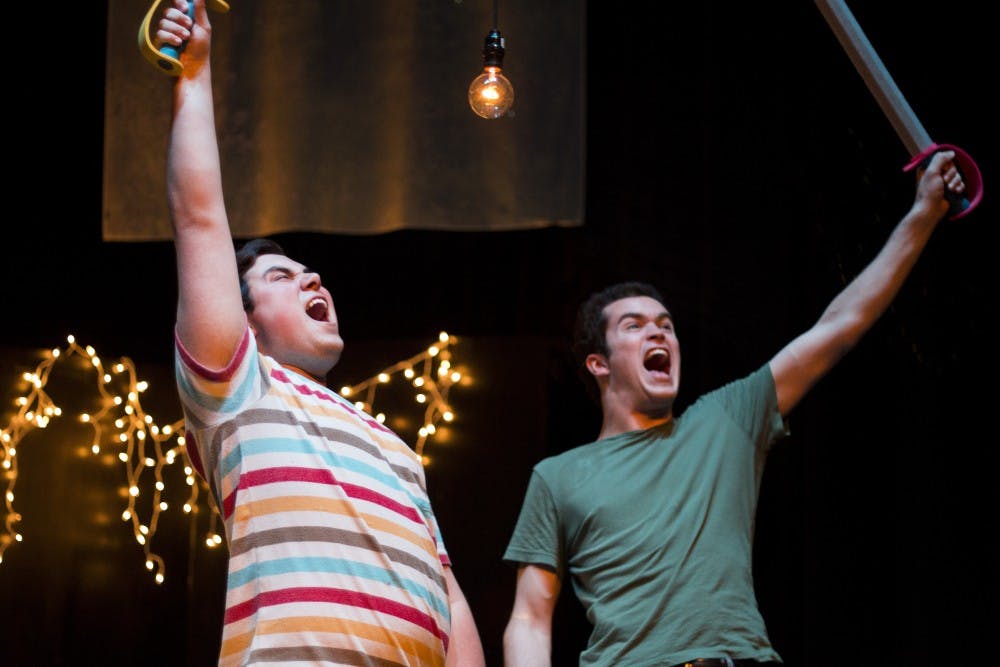What: Friends in High Places
When: April 19-23 at 7:30pm; and April 23-24 at 2:30pm
Cost: General Public $6
Where: Cave Studio Theatre
In this coming-of-age story, three friends who have known each other since they were 6 years old are graduating high school. With their treasured diplomas comes something more ominous, though — the knowledge that their childhood is over, and the question of whether their friendship is, too.
In the play, they are spending their final night together before parting ways for college.
“Their night is punctuated by memories of their 12 years of friendship, and we see how they’ve loved each other over the years and how they’ve been changed by one another,” said senior theatrical studies major Gabbi Boyd, the playwright of this piece. “It’s a gritty, turbulent, rough-around-the-edges portrait of three characters who are deeply flawed and deeply lovable.”
Freshman acting major Will Rupert plays one of these friends, a musician named Luke. In addition to struggling with his music, Luke also has to confront the challenge of maintaining friendships from high school.
“Luke has to deal, basically, with what happens post-high school graduation,” said Rupert. “His friends are moving away, and he’s trying to figure out what his place in the world is, and what his place with these people he’s close with is, as well.”
This play was selected from several submitted scripts, and director Savannah Cousins, junior double major in directing and lighting design, expressed that she was drawn to Boyd’s work because of how relatable it is.
“The shows I’ve seen on stage this semester and out in the world have been interesting and relating to experiences,” she said, “but this relates to real experiences we’ve had as college students. That’s refreshing, and I’m excited to tell this story.”
Although the original manuscript was around 40 pages long, the draft being presented in the Cave has grown to over twice that length.
Being able to work with the playwright in such a capacity gave the director and actors a unique opportunity to play a part in the development of the story and the characters.
“As a director, it’s rare to have input about the stories you’re telling,” Cousins said.
Likewise, this is a rare opportunity for the playwright herself, and also the audience members for this show.
“Seeing a brand new play is such a unique, fragile experience, and as a playwright, the ability to get tangible feedback from people seeing the show is invaluable,” Boyd said.
This kind of feedback sometimes meant that Boyd had to “kill her darlings,” as the saying goes. In art, this means when one must sacrifice an aspect of the piece the artist loves in order to create a better end result.
“I had to sacrifice what felt like a more powerful theme in order to tell a more interesting, honest story,” Boyd said. “It’s hard to not wonder if earlier versions of your work were better, but I’m confident in what we’ve created.”
Despite the changes, Boyd believes that the essence of her play has remained consistent from her initial inspiration.
“The image of friends smoking weed in the woods on a playground against a starry night sky was the first thing that looked like the story I wanted to write, and I ran with it,” she said. “I think that image is still the backbone of the play, and everything I have to say about youth and memory can sort of be contained in that in a way.”
In regards to genre, “Friends in High Places” is a memory play, and this drove much of Cousins’ directing decisions. However, unlike many memory plays, this one strives to represent a shared memory instead of that of a particular character.
“I wanted to create a space in which a shared memory could exist,” she said. “It’s a composite photo. They always look a little weird like panoramic shots: you get the full picture, but some things get distorted.”
Beyond representing the memories of these characters, the message of the show applies to anyone who has gone through this kind of transition period in their lives.
“It’s a memory play for the characters, and, in a lot of ways, it’s a memory play for me and [Boyd] and everyone who watches it,” said Cousins. “There’s something very unique about that time because you’re almost an adult but not quite. Your brain is full of funny hormones, but your feelings are perfectly valid and important.”
Boyd expressed that validating these emotions and experiences was an important aspect of her writing process.
“I wanted to write an ode to youth, and I didn’t want to belittle it,” said Boyd. “There are stories about teenagers that paint them as cartoons or idiots, and I wanted to tell a story about teenagers that was magical and angular and rough like sandpaper.”
What: Friends in High Places When: April 19-23 at 7:30pm; and April 23-24 at 2:30pm Cost: General Public $6 Where: Cave Studio Theatre





